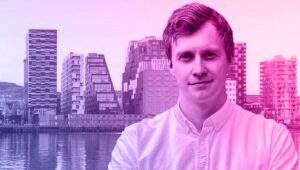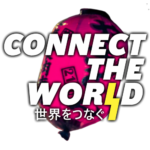
Aryan Jabbari | Connect the World
Buy Pepes with Lightning!
This week, in Episode 35, we talk to Aryan Jabbari, technical co-founder of Scarce City, an online marketplace for Bitcoin goods and Bitcoin NFT’s.
Aryan started Scarce City together with Chris Tramount. They had help from honorary founder Chiefmonkey. He seeded the artist community and had the original idea for bitcoin-based auctions. They believe that everything needs to be sold pseudonymous, borderless, permissionless, trust minimized, and verifiable authenticity and supply.


Lightning
What was your first experience with the lightning network and do you still know what you did/saw at that moment?
My first experience with the Lightning Network was working on Scarce City. My cofounder suggested BTCPayServer as a starting point for standing up a payment processor and, as you know, they offer LN integration.
At that point, I saw the inherent need for PayPal and/or Stripe float away. Why jump through hoops and fees that PayPal and Stripe impose when we have Lightning?
I didn’t really grasp the concept of “permissionless” at that point but these were definitely the seeds to my understanding that Lightning represents a permissionless bank and self-sovereignty.
What security concerns of the lightning network do you think are undervalued nowadays?
I’m probably not the best person to answer this question, to be honest. I’ve only begun studying the Lightning Network.
If you look back to the last years of Lightning development and have to look 4 years in the future, where do you think we are with Lightning by then?
Lightning will be more than just payments and products like Sphinx will continue to grow and expand.
Text chats via lightning will begin to replace Telegram for a portion of Bitcoiners.
Lightning empowers local economies, such as the famous Bitcoin Beach (but shout out to Bitcoin Ekasi, Praia Bitcoin Brasil, Lago Bitcoin and others). These “local economies” will grow in different corners of the world. These corners of the world will be escapes from Clown World for all of us. As more and more Bitcoiners into these escapes, those economies will grow. The independent local economies will soon enough interact with each other. This is how a Bitcoin economy is achieved.
What type of merchants will be the key to get more adoption? Big companies like Amazon, apple,…?
What is in your opinion necessary to see more adoption in the near future?
The key to more adoption will be payment processor integration. For example, tons of small businesses around me use the Toast and Clover payment processors. These payment processors accept the usual suspects (credit and debit cards, fiat, etc.). If these big payment processors chose to accept lightning, I think many consumers buying cup of coffee would opt to use their lightning balance.
However, I’m more interested in using Lightning adoption as a pathway to Bitcoin education. My community has a weekly “vendor showcase” outside on the street. A lot of these vendors only accept cash payments and avoid Square, etc. due to high fees. These small businesses (literally businesses of one) are perfect early Lightning adopters. Explain Breez wallet to them, explain the low-fees and explain that they’re their own bank and you’ve got a new Lightning user on the hook. From there, you can explain how Bitcoin Fixes This…
When looking at fiat payment Processors, there are quite a few large companies such as Adyen, PayPal, Stripe, etc.
Do you think there is a greater chance that Bitcoin and Lightning payment processing will be offered by a new player that is not 1 of the already existing companies that are now only engaged in fiat transactions?
In the “western world,” (namely America), no. Given Cash App’s success, I think Stripe and PayPal will jump on the opportunity to accept Bitcoin / lightning.
However, there are entire lightning economies manifesting all over the world. Since these economies are already “lightning-enabled,” THIS is where the new lightning payment processors will be born, bred and iterated upon. This is why it’s so important we support the “Bitcoin Beach model:” it contributes to decentralization.
What is the most stunning thing (thing/application/movement) you have seen on the lightning network?
The most exciting movement on the Lightning Network is quite easy “The Bitcoin Beach movement” (there needs to be a better term for this). It’s quite literally a breeding ground for Lightning education, economy, innovation, etc. It’ll attract the best, brightest and hardest working.
In terms of innovation, anything created by Ben Arc. The man just hacks and builds and hacks and builds. He’s built an offline point-of-sale for lightning (https://github.com/arcbtc/LNURLPoS) which is obviously important in places where cellular and internet access is a bit spotty. He’s organized and bootstrapped LNBits which he describes as “Wordpress for Lightning.” He’s built silly things like a fly swatter triggered by a lightning payment that hits him in the face live on video (https://twitter.com/arcbtc/status/1371569572512460800). The man is a beast.
Do you use services like satsback.com or do you know other services for earning satoshis?
I do not use many services for earning satoshis. However, as products, I love services like Sats 4 Likes and games on THNDR Games that leverage lightning’s microtransaction capabilities. Other services that support the creator economy are high-up on my favorites as well. For example, it’s great incentive for podcasters that can have sats streamed right to them.
I believe the best way to stack sats is by contributing to the Bitcoin / Lightning economy in some way. It can be a new product, newsletter, etc.
You live in Queens NY, do you use the Lightning Network in your daily life? For example buying goods with your bitcoin?
I frequent a “vendor mall” with small, one-person businesses. Only one of them accepts lightning at the moment but I’m working on introducing others.
We have LND (lightning labs), c-lightning (blockstream), eclair (Acinq) and some more… These are all implementations on the second layer. What lightning implementation do you prefer at the moment?
I’ve only used LND this far.
Support us in our mission
Do you like this article and our other content? Donate and support us in our mission to create a worldwide distributed Lightning Network by connecting countries around the world and bringing The Lightning News to you first!
Follow The Daily Moon also on Telegram and Twitter!
Scarce City

Scarce City is a marketplace that uses Bitcoin technology to sell Bitcoin goods for Bitcoin. How did you start Scarce City and what was and is your role?
I’m the CTO of Scarce City but usually just call myself the old school name of “Webmaster.”
My cofounder, Chris, and I worked at the same fiat job where I was a mobile developer. COVID hit and we were both laid off. He approached me and pitched me the idea for a company selling apparel for Bitcoin. I wasn’t into Bitcoin at the time but always wanted to learn more. I took my new free time (thanks COVID) to learn some Bitcoin and build a website that accepts Bitcoin for apparel.
It was pretty much a flop. We sold about ten t-shirts, including the t-shirts we bought and others that our parents bought. Chiefmonkey already supported us at that point and saw the potential for an auction house powered by Lightning (using Lightning as collateral). It took me about a month and a half to build the first iteration of our auctions. Shortly after, we featured Chiefmonkey’s inaugural piece (rightly called “Relentless Optimism”) and the rest is history.
Do you see Scarce City more as a marketplace or as an Art Gallery?
At the moment, Scarce City is an art gallery as we specialize in art. However, we’re inching away from art at the moment and broadening our scope.
I’ve got some features in the pipeline that will open it up to different types of Bitcoin goods which will make it more of a marketplace.
What is your biggest goal with Scarce City? Is that getting more adoption, your belief in NFT art or something else?
Scarce City’s goal is to be a hub of Bitcoin culture. It’s an honor for us to onboard newbies to Bitcoin through our space and that’s definitely a second goal in our mind.
At Scarce City you believe that everything needs to be sold pseudonymous, borderless, permissionless, trust minimized, and verifiable authenticity and supply. Why is this a perfect fit when thinking of Bitcoin and Lightning technology?
I have to thank my cofounder, Chris, here as he orange-pilled me and showed me the Bitcoin way.
At Scarce City, we don’t require our sellers or buyers to KYC and will continue to serve the Bitcoin community without KYC as long as legally possible. This is made possible through Bitcoin and Lightning’s borderless and permissionless properties. If we accepted fiat, we’d need all this unnecessary information on our users. With the way we’re set up, we know our users via their pseudonyms and we’re extremely happy with that.
Furthermore, we don’t care which fiat borders you’re surrounded by. In the end, we’re all Bitcoiners and if you’ve got beautiful Bitcoin art (I’d love to see more Lightning art, by the way!) to share, we’d love to to have it on our platform.
Honorary founder Chiefmonkey seeded the artist community and had the original idea for the bitcoin-based Auctions. He also built a Lightning Powered and Twitter integrated marketplace where anyone can sell anything and it’s called plebeian.market. Still a minimum viable product and proof of concept. Do you think these initiatives will be a big driver for adoption of Lightning?
Chiefmonkey, what an innovator. Initiatives like these are extremely important in building a Bitcoin economy around lightning technology. I’ve seen plenty of potential bidders and buyers that understand how to use Bitcoin but never had an excuse or need to learn how to use lightning.
With the low barrier of entry (download Wallet of Satoshi or Breez, deposit some sats, and get to zapping QR codes), it’s not too difficult to explain how to use lightning. With a piece of art that they want in their mind combined with the usually curious Bitcoiners mindset, they’re normally enthusiastic to do it and give lightning a shot.
And once you go lightning, you never go back.
What’s the biggest problem you encountered with building Scarce City?
At Scarce City, we take collateral via lightning or on-chain Bitcoin and refund the sats after an auction via lnurl-withdraw QR codes.
I read lnurl-withdraw’s spec and went on to code up an implementation. In hindsight, I could have just used something like lnbits to manage all that but I was new to all of this and didn’t realize this was a pretty much solved problem. I basically reinvented the wheel…incorrectly. My lnurl-withdraw’s implementation had a bug in it that allowed some users to double dip their withdrawal.
I went into the lnurl mafia Telegram group and asked for help. A user by the name of “fiatjaf” offered his time and walked through the code I wrote. He found the root of the bug pretty quickly and helped me patch it up. He even complimented my code and said, “that’s beautiful code you have there.”
It was a few months after that that I realized fiatjaf is actually a big deal around these parts and that he’s humble enough to help a newbie with his code. And, given that fiatjaf is a god amongst men, that compliment means a whole lot now.
It’s possible to pay for Pepes from any Lightning Wallet. The Pepes are sent to a Counterparty Wallet. Can you explain what a Counterparty Wallet is used for and how the buying and selling process works?
Counterparty is a protocol built on top of Bitcoin. It encodes data into the OP_RETURN of a Bitcoin transaction. A Counterparty node can decode this data. This data includes all Counterparty sends, dispenses (sales on Counterparty), orders, issuances, etc.
A Counterparty wallet is mostly a Bitcoin wallet with the added functionality of interacting with a Counterparty node to display assets that a specific address or set of addresses owns. It also allows the sending and issuing of Counterparty assets.
In the beginning of this year the Rare Pepe Wallet announced they were pausing all withdrawals, swap and transfers between accounts due to the extreme market conditions. What is de RPW exactly and do you know what happened?
Heh, Joe Looney is going to kill me. He is the creator of Rare Pepe Wallet and a good friend of mine. I like to play occasional jokes on him and his Rare Pepe Wallet creation. When the Celsius drama happened (where they refused to allow withdrawals), I edited their email to make it look like Rare Pepe Wallet did not allow withdrawals. I guess my Photoshop skills are just that good where a lot of people actually thought it was a Rare Pepe Wallet that had that outage. Sorry Joe!
A lot of people have a strong negative opinion about NFT’s. Can you explain here why you think it also can have a positive side?
I believe the bulk of the negative opinions about NFTs come from the scams and rug pulls seen over the past few years, especially with the explosion of NFTs into mainstream culture and media. And, quite frankly, a lot of the criticism may be justified. It is a scam-heavy space but I don’t know if that means 100% of every single NFT project ever is a scam. Furthermore, a lot of the scams you’ll see is happening over in the Ethereum and whatever other shitcoin space out there.
The Counterparty community is one of the earliest “NFT” communities (though the community existed way before the buzzword NFT was a thing). It stemmed from a community that wanted to create scarce assets. They used the technology available at the time which was the Counterparty protocol. The community is quite an honest bunch and, while not entirely scam-free, has a LOT fewer scams than their Ethereum counterparts.
Anywho, with that said, NFTs can just be fun in the same way trading cards or comic books can be fun. A community is built around that for us to geek out and talk about. Not everything on Bitcoin needs to be so serious.
I believe that there are a lot of artists that want to sell digital aspects of their work, but only when this works on Lightning. How is it possible to verify authenticity with the use of Lightning for example? And is it possible to prove ownership?
I don’t think it’s currently possible but we’re a short-time away from having it available to us via Taro. Taro will allow for assets to be issued on the bitcoin blockchain and then transferred over LN. It may not be 100% LN but it’s 100% and is coming soon.
I went to art school myself and remember it being very conservative. I must admit that I understand and like the possibility to sell art with Lightning and also to create and sell digital art. But I believe that the mainstream find the work presented in the auctions on Scarce City difficult to understand or see it as art.
Do you think this is a generation problem or a problem of bad publicity of NFT’s or something else?
It’s two things: bad publicity around “NFTs” and gatekeeping by the old art world in terms of “what is art?”
I’ve explained the bad publicity around NFTs. I cringe every time I see a new NFT scam (thankfully they’re normally on Openshit, erm, I mean Opensea) because I know Bitcoin assets will be associated with these shit scams.
There’s this gatekeeping that frowns upon digital art. If they’re not frowning down on digital art, they’re frowning down on monetizing digital art. All the gatekeeping is a bit silly, really. Some of the digital art that is frowned upon is created by well-respected artists in the “contemporary art” world, sold as a physical, and then sold as an digital asset. If digital asset collectors want to collect and trade these assets and are doing so with their own free will, then what’s the problem?
Do you think that initiatives like Scarce City will have their part in changing the way existing art galleries and museums look at art?
Scarce City’s physical presence at events like Bitcoin Conference and NFT.NYC shows that these digital assets that everyone frowns upon can be impressively artistic.
We recently held a Pepe Gallery which was basically an art gallery full of Pepes in Tribeca, New York City. We had tons of traffic off the street who were genuinely impressed by the art. Some even wanted to bid on the art and take it home. They unfortunately balked when we explained that we only accepted Bitcoin.
Will Scarce City open his doors for more than only Bitcoin collectibles or is this not your goal?
I don’t think, say, a car engine is something we’ll have on Scarce City. Scarce City looks to push Bitcoin culture forward.
Because you’re working with a small team you now curate new submissions through a form on the site. What is your current growth and when can we expect more collaborations or new artists in your gallery?
We have a bit of a bottleneck in terms of submissions as we need to look through all submissions and then take those submissions and enter it into our system. I’m working on allowing submissions to create their own pages on Scarce City.
Our capabilities are growing little by little and, now without a focus on an upcoming gallery, you can expect a lot more collaborations and new artists this year.
Do you also see it as your task to convince other digital marketplaces of the Bitcoin/Lightning only possibilities?
I don’t evangelize too much but when I see a chance to convince someone to accept Bitcoin/Lightning, I usually take it. As for going Bitcoin/Lightning only, I know a lot of people are struggling to make ends meet and it may be difficult for them to pay their fiat bills by going Bitcoin-only. Soon enough the Bitcoin economy will be strong enough to allow this though!
Extra
When did you start the scarce-city node, what’s it running on and where do you use it for?
I started the scarce-city node along with Scarce City. It runs in AWS, specifically alongside BTCPayServer. We use it to accept lightning payments and give out our refunds.
What management tool do you prefer to use with your node and why?
I use RTL. Honestly, I use it because it was the tool that came with BTCPayServer.
What was the most difficult experiment you did on/with lightning?
Writing lnurl-withdraw from scratch was the most difficult and costly experiment I ran on lightning. A bunch of million sat double dips taught me to fix it really quickly. Shout out to fiatjaf for the help!
You used LnNodeinsight to research which channels to open to connecting better to mainstream Lighting Wallets. Do you use more tools to check the metrics of your node?
I think you mean Amboss.
I mainly use Amboss to check on the metrics of my node and the nodes I’m connected with. If I find I’m connected to a node that looks down, I’ll try to get in touch with them. If I can’t, I normally close the channel.
You did recently a Pepe Gallery in NYC. Can you explain an bit what it is and how it went?
The Pepe Gallery was a great time. It was a means to get the Pepe community together and get to know each other. We had a giant frog in the window and had a bunch of traffic from outside come in and tell us how much fun our frogs were.





Ramon Korpel


LNcapital, node management for professionals | Henrik Skogstrøm






